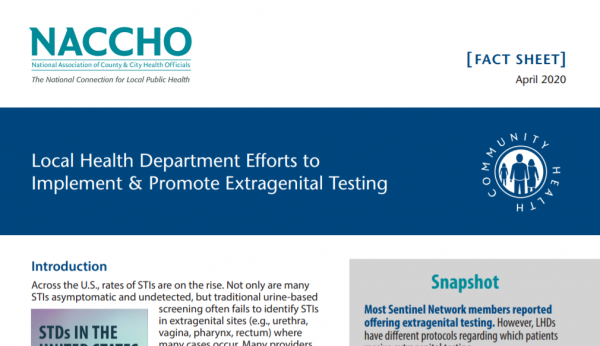Across the United States, rates of sexually transmitted infections (STIs) are on the rise. Local health departments (LHDs) are on the frontlines, responding to these epidemics and assuring access to testing and treatment in their communities. Not only are many STIs asymptomatic and undetected, but traditional, urine-based screening for chlamydia and gonorrhea often fail to identify STIs in extragenital sites (e.g., urethra or vagina, pharynx, rectum) where many cases occur. For example, in men who have sex with men (MSM) – a population disproportionately impacted by rising STI rates – urine-based screening misses more than two-thirds of gonorrhea cases and more than three-fourths of chlamydia cases.
Many providers are unaware of the importance of extragenital testing and others face barriers to utilizing it. Since two-thirds of LHDs offer STI testing and all play an important role in promoting best practices at the local level, their efforts are critical to the expansion of extragenital testing. To assess LHD efforts to implement and promote extragenital testing, NACCHO queried a convenience sample of its HIV, STI, and Viral Hepatitis Sentinel Network members – who include LHD staff working in HIV, STI, and viral hepatitis programs – in February 2020. Of the 130 Sentinel Network members, 83 responded to the assessment for a response rate of 64%. Sentinel Network members are recruited through NACCHO’s communications channels and via direct outreach to LHDs in geographic areas underrepresented in the Sentinel Network. Although not nationally representative, members work in LHDs of varied jurisdiction sizes and geographic locations and settings. Read on to learn more about what we found and check out our new fact sheet to learn more.
Extragenital Testing Practices & Resources
Most respondents (84%) indicated that their LHD offers extragenital testing. Of those, approximately two-thirds offer extragenital testing based on patients’ reported sites of exposure, one-fourth based on population (e.g., MSM), and one-fourth offer extragenital testing to all patients. This suggests that extragenital testing rates are high at LHDs, but patients’ access to it may depend on disclosure of specific sex practices.
Extragenital testing practices vary from LHD to LHD. Approximately two-thirds (65%) of respondents whose LHDs conduct extragenital testing report the use of self-collected samples, which can increase uptake of STI testing  due to increased confidentiality and convenience. Funding mechanisms also vary. The vast majority (86%) of LHDs that offer extragenital testing use state or local funding to pay for it. Just under half report collecting a fee for service (46%) or billing third-party payers (45%). Of note, only 51% of LHDs that offer extragenital testing bill for any STI testing, which suggests that most LHDs that have the capacity to bill can do so for extragenital testing.
due to increased confidentiality and convenience. Funding mechanisms also vary. The vast majority (86%) of LHDs that offer extragenital testing use state or local funding to pay for it. Just under half report collecting a fee for service (46%) or billing third-party payers (45%). Of note, only 51% of LHDs that offer extragenital testing bill for any STI testing, which suggests that most LHDs that have the capacity to bill can do so for extragenital testing.
Extragenital Testing Needs and Barriers
Of LHDs that currently offer extragenital testing, 41% report that it’s fully scaled-up at their health department. LHDs that are not offering extragenital testing shared what they would need to fully scale it up, including: funding (42%), increased staff or leadership awareness of the importance of extragenital testing (22%), and increased staff knowledge of extragenital testing practices (14%). This indicates that there is a need for funding and workforce education and development to ensure extragenital testing is fully scaled up at LHDs across the country.
As aforementioned, 15% of respondents indicated their LHD does not offer extragenital testing. More than half (54%) of these respondents indicated they don’t offer any STI testing, but other common reasons for not offering extragenital testing include a lack of funding (38%) and lack of staff training (23%). When asked what factors  would enable them to offer extragenital testing, more than half (54%) said funding, 31% said updated screening and/or sexual history-taking tools or protocols, and 31% said increased staff or leadership awareness of the importance of extragenital testing. Several respondents wrote in other barriers and needs, mentioning a need for protocols (e.g., for use of self-collected samples, oral treatment, and outreach testing), a lack of providers or limited staff capacity, or insufficient lab capacity or personnel.
would enable them to offer extragenital testing, more than half (54%) said funding, 31% said updated screening and/or sexual history-taking tools or protocols, and 31% said increased staff or leadership awareness of the importance of extragenital testing. Several respondents wrote in other barriers and needs, mentioning a need for protocols (e.g., for use of self-collected samples, oral treatment, and outreach testing), a lack of providers or limited staff capacity, or insufficient lab capacity or personnel.
Extragenital Testing Promotion Efforts
In addition to providing STI testing and treatment, LHDs work to assure access to high-quality services outside of their walls—an important component of which involves ensuring local providers are using best practices and following up-to-date guidelines. Nearly half (46%) of respondents indicated their health department promotes  extragenital testing among providers in their community. LHDs shared a variety of strategies to promote extragenital testing, such as conducting provider education, including through coalitions; sending out newsletters and educational materials; and conducting academic detailing. Others shared that they offer continuing medical education credits to encourage provider participation in educational sessions, and one respondent reported their LHD is providing mini grants to local clinics to create protocols and train providers.
extragenital testing among providers in their community. LHDs shared a variety of strategies to promote extragenital testing, such as conducting provider education, including through coalitions; sending out newsletters and educational materials; and conducting academic detailing. Others shared that they offer continuing medical education credits to encourage provider participation in educational sessions, and one respondent reported their LHD is providing mini grants to local clinics to create protocols and train providers.
Overall, most Sentinel Network members reported that their LHD offers extragenital STI testing, and nearly half reported efforts to promote extragenital testing among local providers. There are a variety of barriers that affect the ability of LHDs to implement extragenital testing, including funding, staff training, and lab capacity. However, despite these barriers, many LHDs have found ways to offer and promote extragenital testing, assuring access to high-quality and accurate STI testing and treatment in their communities



